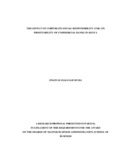| dc.description.abstract | The purpose of this research is to determine the relationship between corporate social responsibility and profitability for commercial banks in Kenya. Corporate social responsibility consisted of expenditures on healthcare, scholarships, environment, and recreation and sports. Profitability consisted of Return on Assets obtained from financial statements. This study uses a sample of firms which participated in CSR activities and made data public. It excludes firms that either did not participate in CSR or did not release CSR data. Data for the five year period from 2009 to 2016 was analyzed. The study conducted multiple regression analysis on the data to determine the effects of CSR on profitability. The independent variables consisted of CSR and Bank Size while the dependent variable was ROA. The results show that size and CSR have strong correlation with ROA. With values close to zero, the correlation of both liquidity and share capital ratio with ROA is weak. The study therefore finds no significant relationship between liquidity and share capital ratio with ROA. The study supports theoretical evidence by demonstrating that a high liquidity ratio limits funds available for investment. It does not support the idea that commercial banks in Kenya gain substantially by maintaining a very high liquidity to pay depositors and creditors on demand. The findings support theoretical evidence by demonstrating a weak and negative relationship between share capital ratio and ROA. It indicates that banks that take up more debt increase ROA due to tax savings. The study findings support the competitive theory as it indicates a strong and positive relationship between CSR and profitability. There is enough evidence to show that commercial banks in Kenya make more profit by responding to stakeholder demands. Most firms invest in similar CSR programs which are scholarships, healthcare, environment, and recreation and sports. This is a clear indication that they respond to the most demanded areas of responsibility but still increase profitability by 6.5 % for every shilling invested. The research also identified limitations and gave suggestions for further research. As the current study did not seek to establish the relevant timelines for which a company returns profit for a particular set of CSR expenditures, further research should be conducted to establish the correct period in which profitability relates to. For the reasons that current research cannot identify and capture the correct CSR practices, further research should focus on only commercial banks which report their CSR expenditures and a structured manner. Finally, further study should incorporate more stakeholders as this research only included the main dimensions of CSR. | en_US |



